Ultimate Guide to Planning Your Wildebeest Migration Safari
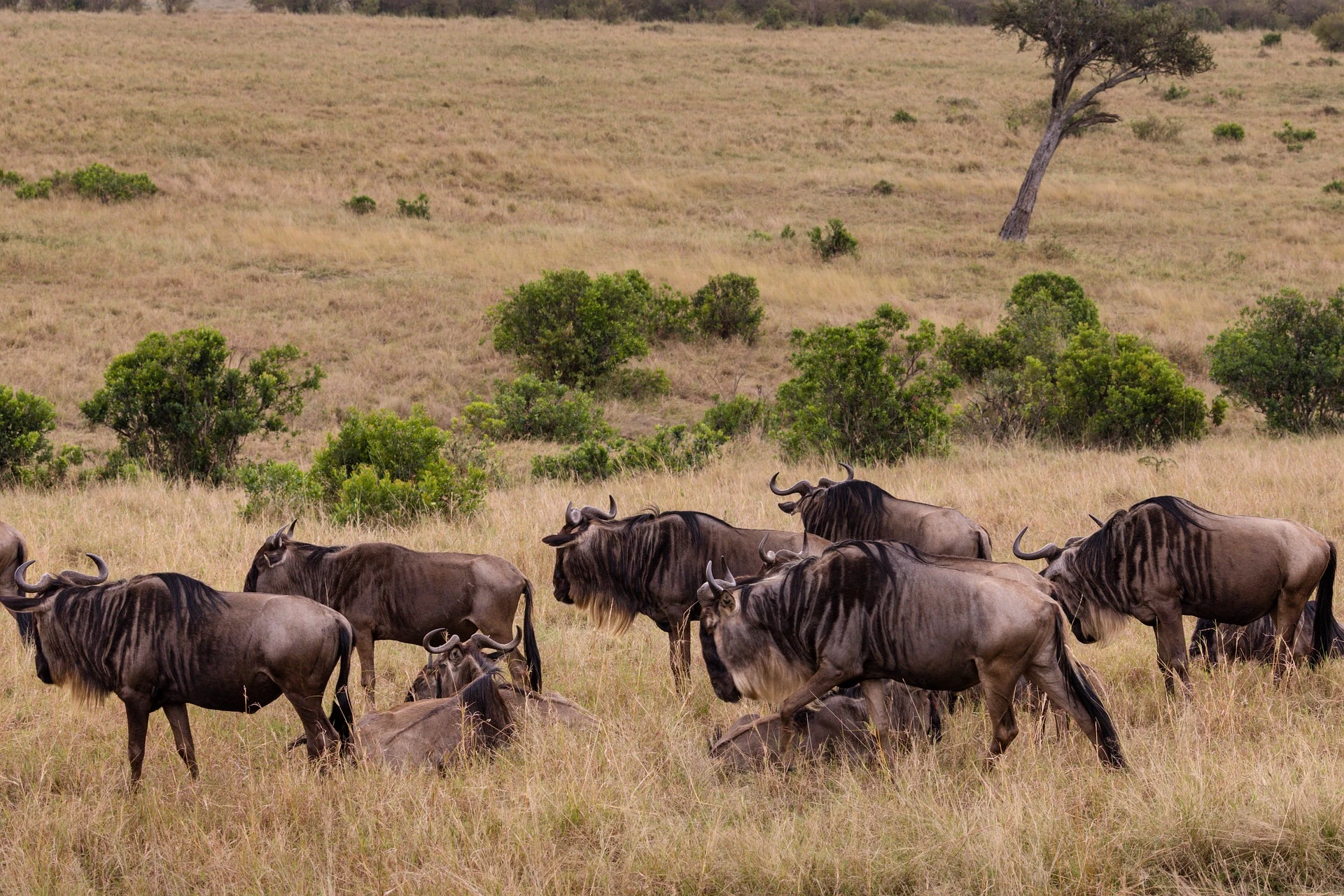
The wildebeest migration is an awe-inspiring natural event where over 1.7 million wildebeest, along with zebras and gazelles, travel across the Serengeti-Mara ecosystem following seasonal rains. This guide will explore the key phases of the migration, the best times and places to witness it, and essential tips for planning a successful safari.
Book Our Kenya and Tanzania Safari Packages Now
You can book our Masai Mara National Reserve & Serengeti National Park Safaris by reaching us through email or phone. Book our Kenya-Tanzania safari tours now via +254-748-258-880. We are also available through email at james@ajkenyasafaris.com or safarioffers@ajkenyasafaris.com.
Our Most Booked Masai Mara & Serengeti National Park Tour
Our Most Booked Kenya Safari Packages 2025 | Price Per Adult Sharing | The Detailed Itinerary |
From USD 27 | ||
From USD 1475 | ||
From USD 1715 | ||
7 Days Safari in Kenya | From USD 4283 | |
15 Days Kenya & Tanzania Safari | From USD 6235 |
Photos Of Migration & Safaris
Key Takeaways
The Great Wildebeest Migration is a year-round journey involving over 1.8 million wildebeest and other herbivores, driven by food availability and seasonal rains between Tanzania and Kenya.
Key phases of the migration, such as the calving season and perilous river crossing, provide unique viewing opportunities and experiences for safari-goers from January to December.
Planning a Wildebeest Migration Safari requires advance booking and flexibility, with the best times to witness notable crossings of the river occurring from July to October in Masai mara.
Serengeti Wildebeest Migration is usually at the peak from Feb to April, during the birthing season at Ndutu area near Ngorongoro Conservation area in East Africa.

Understanding the Great Wildebeest Migration
The Great Migration is recognized as the largest overland animal migration globally, involving hundreds of thousands of wildebeests, along with zebras and other herbivores. This annual migration is a continuous circular migration in East Africa’s savannah driven by the search for greener pastures, food and fresh grazing areas, guided by seasonal rains. It isn’t just a single, fleeting event, but a year-round journey that follows a predictable route between Tanzania’s Serengeti National Park and Kenya’s Masai Mara National Reserve.
The great migration is a cornerstone of the Mara-Serengeti ecosystem, showcasing an incredible array of wildlife beyond the wildebeest. Zebras, Grant’s gazelles, and Thomson’s gazelles join the wildebeest frantic herds, creating a dynamic and diverse spectacle within the Masai Mara ecosystems. This constant movement ensures that the ecosystem remains balanced, with predators like wild dog, lion and crocodile also playing a significant role at the migration route. Over one million animals, including hundreds of thousands of wildebeest cross to Masai Mara, where a predator attacks the wildebeest funnel once on this side.

Key Phases of the Wildebeest Migration
The Great Migration is a circular journey that covers vast distances and includes several key phases, each with its own unique characteristics and experiences. From the birthing season in the Serengeti to the dramatic river crossings in the Northern Serengeti, each phase is driven by the availability of food and water across the Mara- Serengeti ecosystem.
Knowing these phases helps you plan your Wildebeest Migration Tours effectively by knowing when to visit Masai Mara, Northern and Eastern Serengeti, Serengeti’s Western Corridor, Ngorongoro Crater, Nyerere National Park, or even Private Conservancies.
Calving Season in Southern Serengeti (January-March)
The birthing season is one of the most remarkable phases of the Great Migration, commonly called Serengeti Migration. Between January and March, it is generally believed that half a million wildebeest calves are born during a brief two to three-week period in the short grass plains of Ndutu region of the Southern Serengeti. This period is a spectacle of life and survival, as the short-grass plains of the southern Serengeti, Loliondo, and the Ngorongoro Conservation Area become nurseries for the newborns. Female wildebeest form protective barricades around birthing mothers, ensuring the safety of their vulnerable calves.
During this period, the Southern Serengeti becomes most vibrant, with lush green grass from the previous month’s rainy season nourishing the new mothers and their young. This highlights the cycle of life and the importance of timing and environment in the survival of migratory herds as they continue heading south following the age-old route.
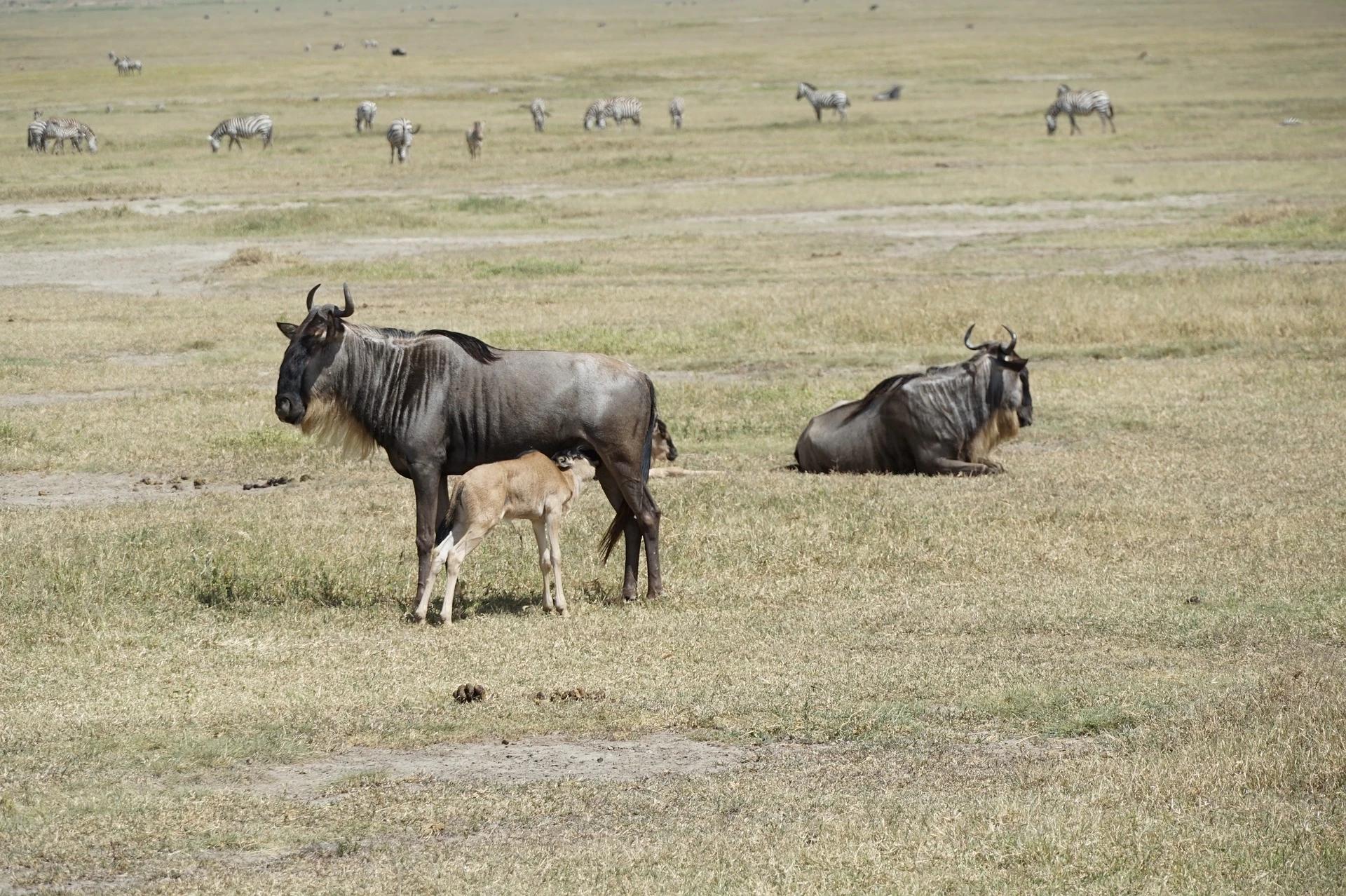
Low Tourism Season in Central Serengeti (April-May)
As April and May arrive, the wildebeest herds start to head north, drifting northwest towards fresher grass, initiating the annual wildebeest migration due to food scarcity and the need to feed their calves. Known for its low tourism, this period offers budget-friendly safari options. With fewer tourists around, you can experience how wildebeest migrate in a more peaceful and intimate setting in the national park.
Towards the end of May, this season is dictated primarily by the mating, adding another layer of excitement to the greatest show on earth of the migration cycle. The mating season is a relatively calm time and wildebeest gather strength for upcoming challenges by feeding on short grass plains, preparing for the dramatic crossings of the river.
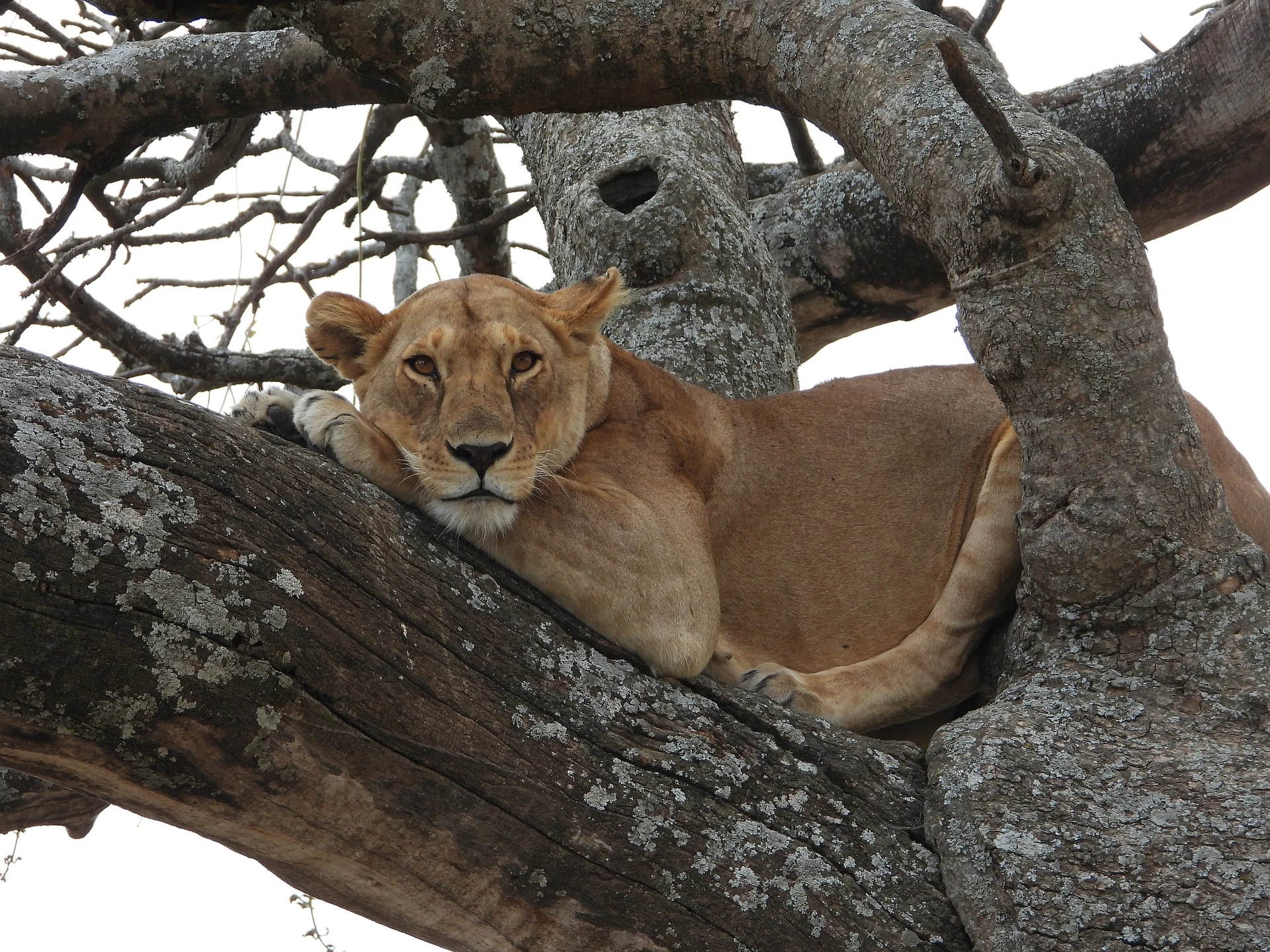
Grumeti River Crossings in Western Corridor (May-June)
The crossings of Grumeti River in the Western Corridor are among the most perilous stages of the migration. In June, large groups of wildebeest gather in the Western Serengeti and on the southern banks of the Grumeti River. With its high concentration of Nile crocodiles, this river becomes a deadly obstacle for migrating herds.
During this time, newborn calves gain strength and start attempting to cross the river, often facing predators like crocodiles, lions, and cheetahs. The river crossing at Grumeti is a dramatic and poignant reminder of the harsh realities of nature, where only the fittest survive. You can see the wildebeest gather at the river’s edge as the herds cross the river with few channels that slows the migration north.
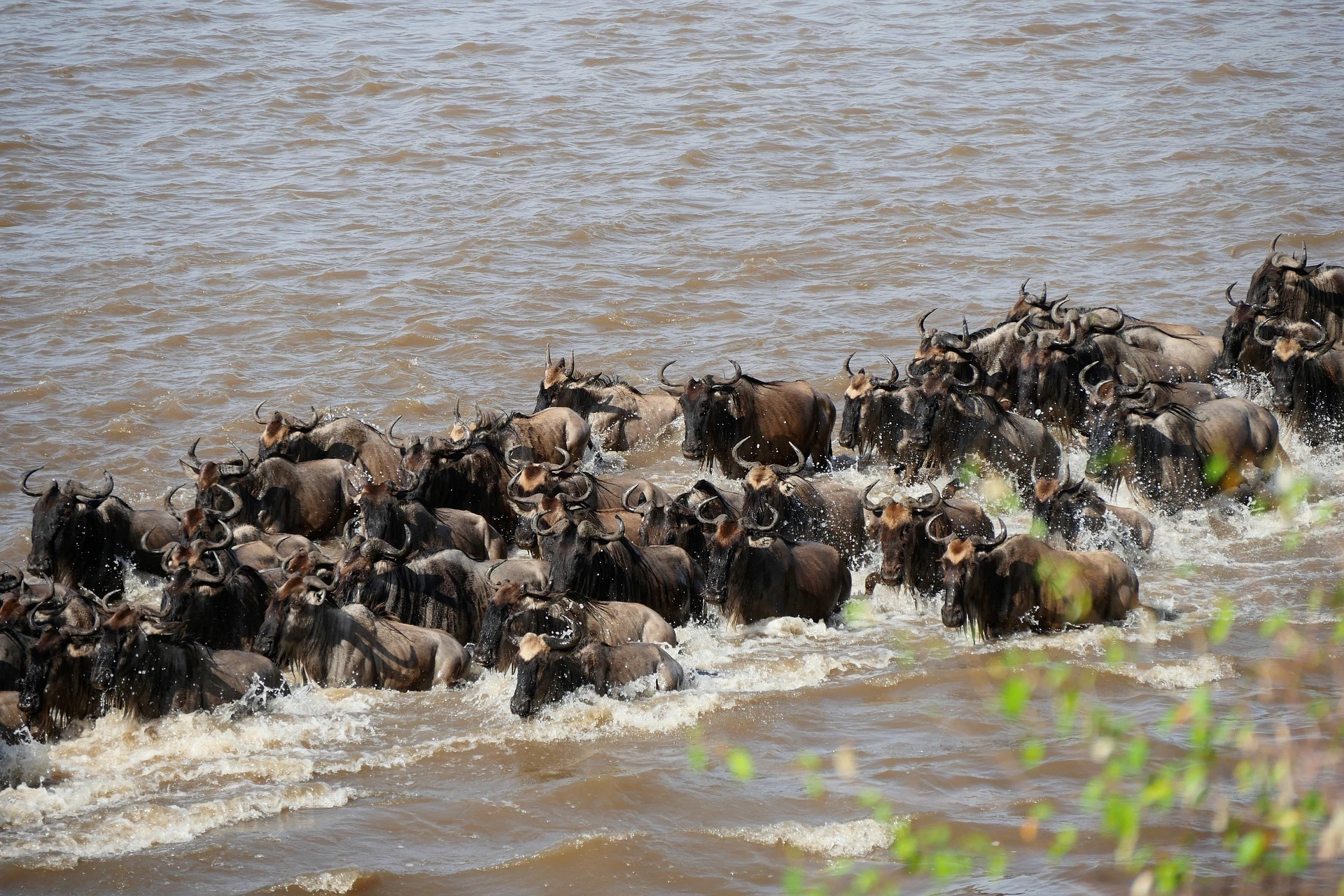
Mara River Crossings in Northern Serengeti (July-September)
The Mara River crossings from the Northern Serengeti to Masai Mara are the pinnacle of the Great Migration, simply known as Masai Mara Migration. Between July and September, wildebeest herds face one of their most significant challenges as they cross the Mara River. Marked by panic, confusion, and threats from predators and strong currents, this period is highly challenging to the largest animal migration.
The crossings are a highlight for visitors, often resulting in the loss of over 200,000 animals annually. The best viewing location for this dramatic event is in the Maasai Mara National Reserve, where there is a 90% chance of witnessing the Masai Mara migration on a 4-day safari.
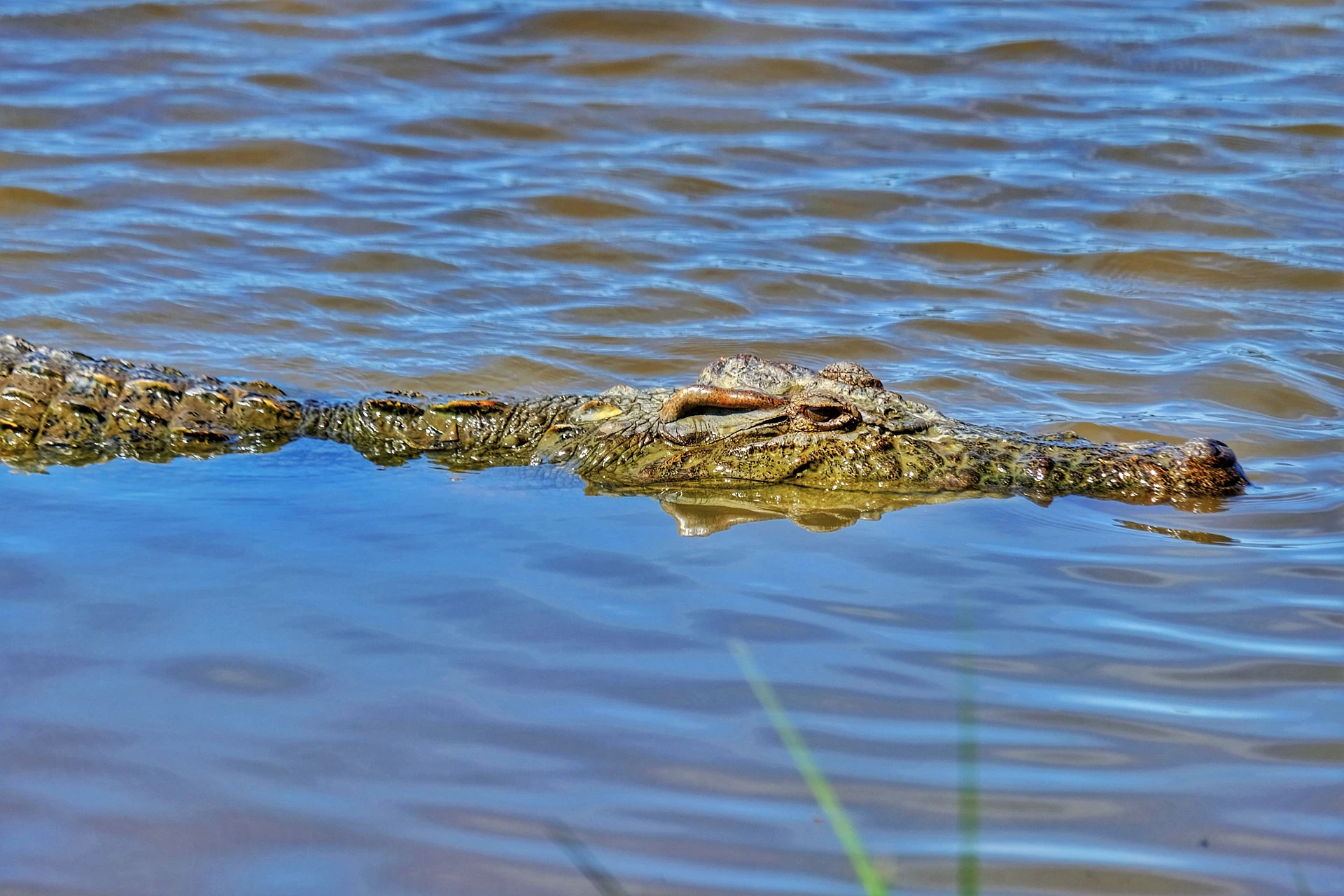
Return South to Serengeti Plains (October-December)
As the Maasai Mara dries out in late October & early November, the wildebeest begin their return journey south to the Serengeti Plains in search of food and water. The final phase of the Serengeti wildebeest migration showcases the resilience and adaptability of these animals as they complete their cyclical journey in early November to December and prepare for the next birthing season.
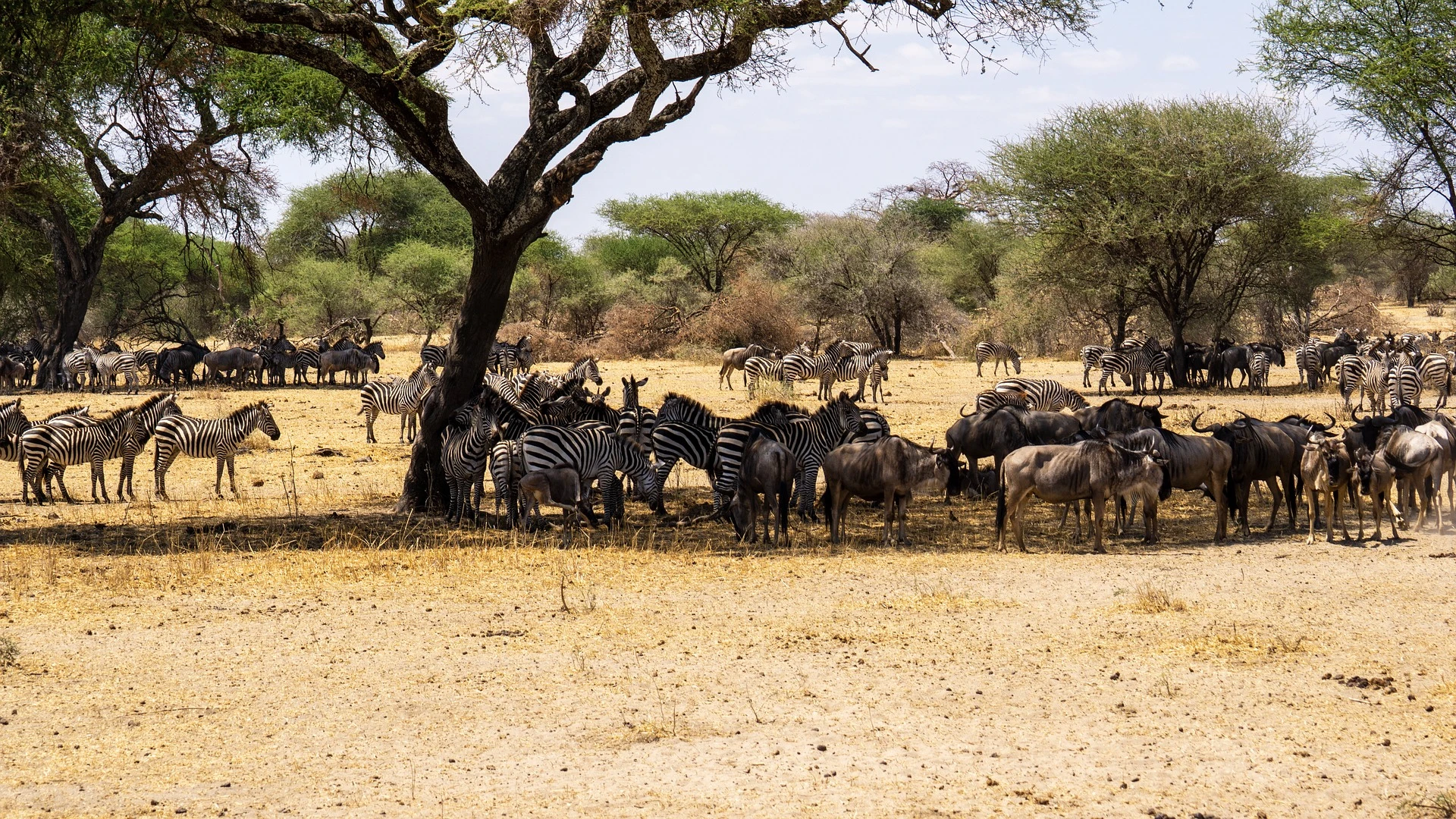
Best Time to Witness the Wildebeest Migration at Masai Mara National Reserve
Witnessing the Great Wildebeest Migration hinges on perfect timing. The best time to observe is from July to October when herds move to Masai Mara from Serengeti. This peak season is highlighted by the thrilling crossings of the river, particularly at the Mara River, which occur from late July to August in Maasai Mara.
For a quieter experience with fewer tourists, consider traveling during the off-peak months of April and May or after the short rains in December.
Regardless of your visit time, planning ahead and maintaining a flexible itinerary maximizes your chances of witnessing this natural phenomenon.
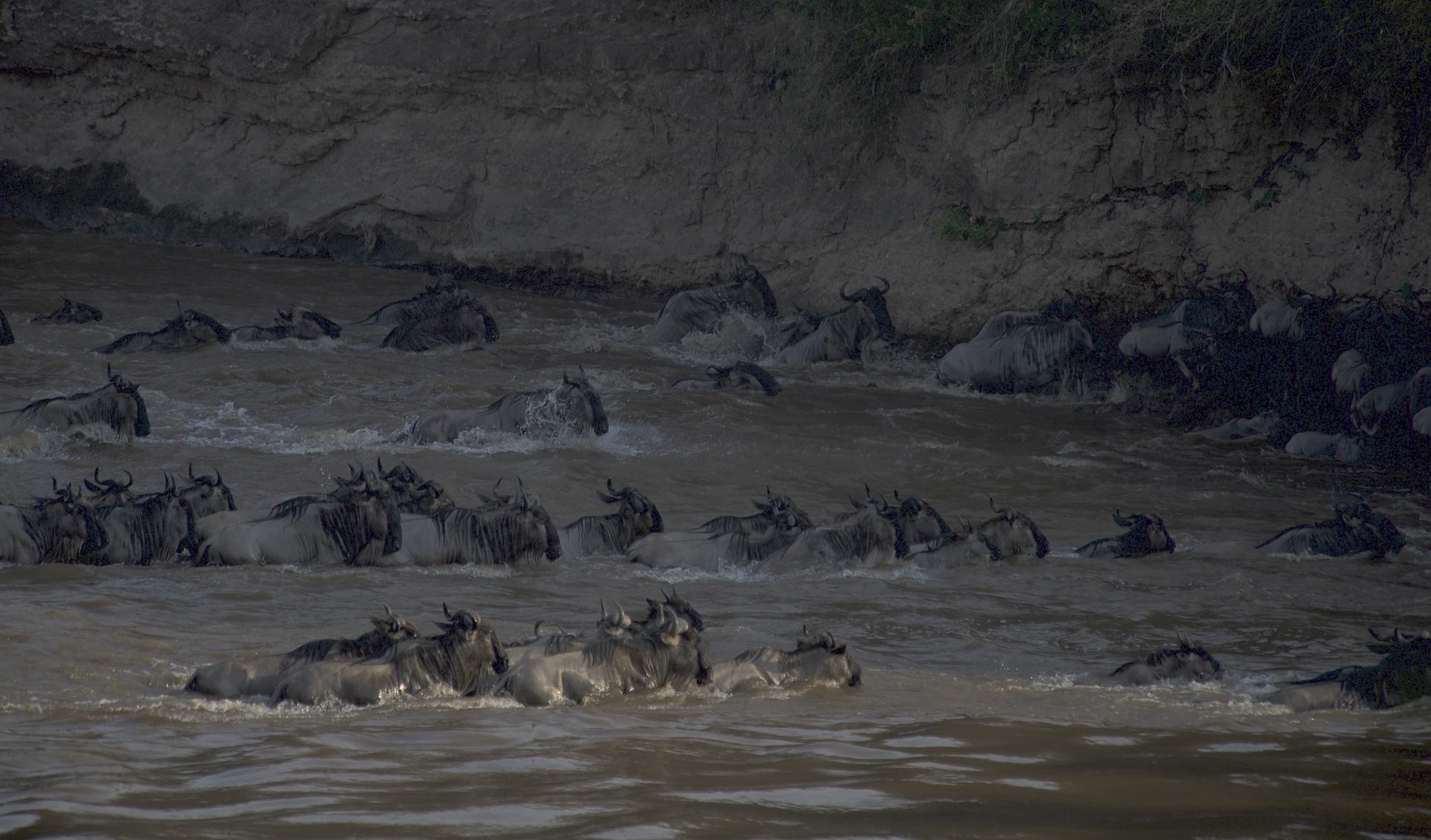
Top Locations for Viewing the Migration
Selecting the right location ensures an unforgettable great migration safari. The masai mara plains are renowned for their spectacular crossings of the river, especially at the Mara River. Camps like Kichakani Serengeti Camp, which adapts its location throughout the year, offer unique opportunities to follow the migration.
Lodges such as Singita Faru Faru, positioned along the Grumeti River, and Sayari Camp in Northern Serengeti, provide excellent vantage points for crossing the river. Additionally, Mahali Mzuri Camp benefits from its location in a private conservancy, offering exclusive and immersive game viewing experiences.

Planning Your Wildebeest Migration Safari
Careful consideration and preparation are essential for planning your Wildebeest Migration Tour. Booking accommodations six to twelve months in advance, especially for peak seasons, can enhance your experience. Safari budgets vary significantly, with costs ranging from \$2,000 to \$10,000 based on accommodations and experiences.
Packing light, breathable clothing, sunscreen, insect repellent, and engaging respectfully with local communities can enhance your safari experience. Guided safaris offer valuable insights into animal behaviors and migration patterns, enriching your adventure.

Types of Safaris Available
Various safari options cater to different preferences and budgets. Mobile camping safaris provide a closer connection to the wilderness and migration for adventure seekers. High-end lodges offer exceptional service and amenities while allowing close encounters with wildlife for those prioritizing comfort and luxury.
Walking safaris provide a unique perspective, allowing exploration on foot and observation of wildlife from a new angle. For a truly breathtaking view, consider an air safari to witness the migration from above. Each safari type offers unique advantages, catering to diverse tastes and interests.
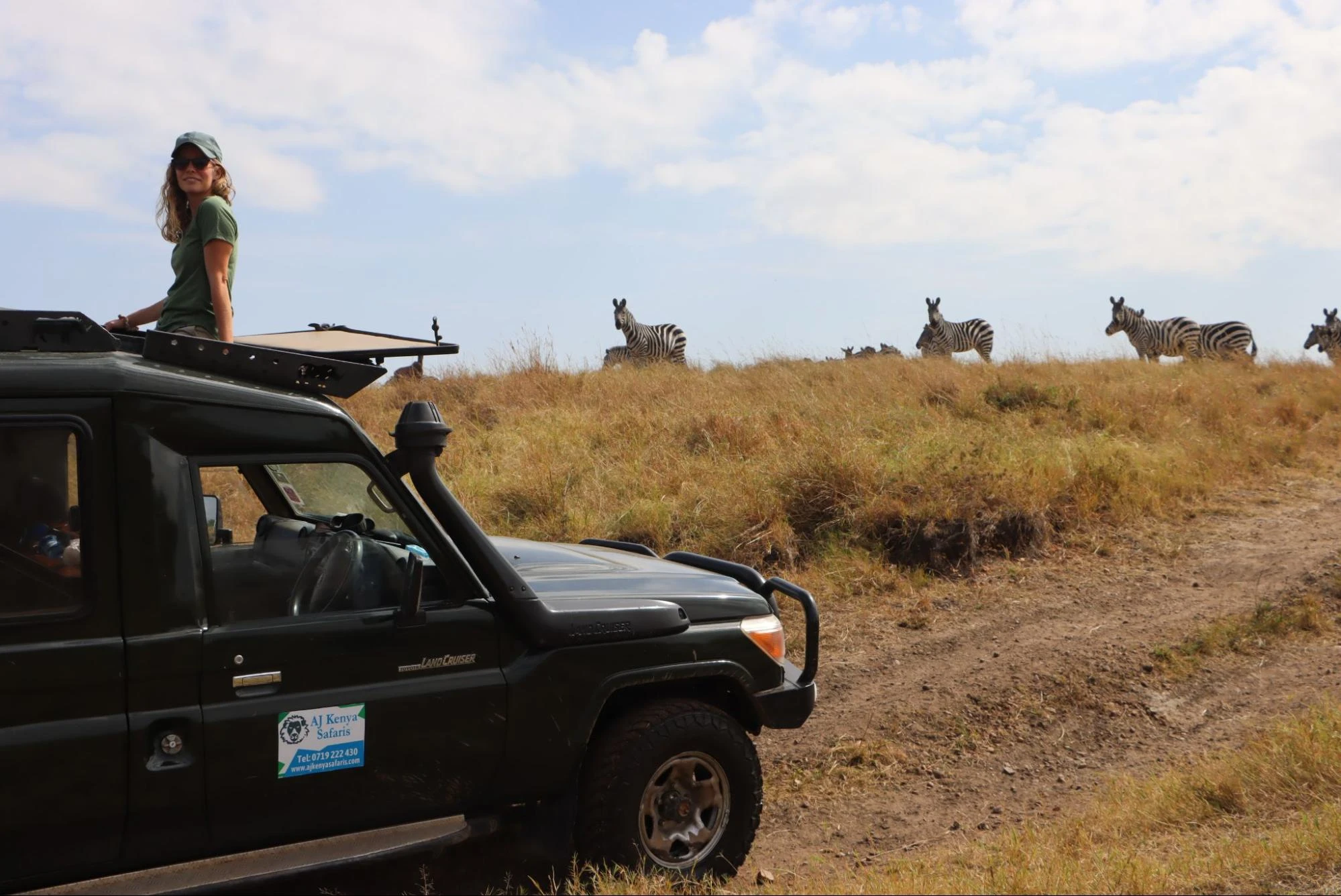
Wildlife Beyond the Wildebeest
Though wildebeest are the main attraction, the Great Migration also includes sightings of various other wildlife. Lions and leopards often take advantage of the dense concentrations of herbivores. Lions in the Masai Mara typically live in prides of 15 to 20, providing thrilling viewing opportunities during safari excursions.
Elephants are frequently seen near the migration routes, drawn by the abundance of food and water sources. Additionally, various bird species, including migratory birds, add to the diverse wildlife experience.
Diversifying game viewing enhances your safari, with destinations like Ngorongoro Crater providing more opportunities for remarkable wildlife encounters.
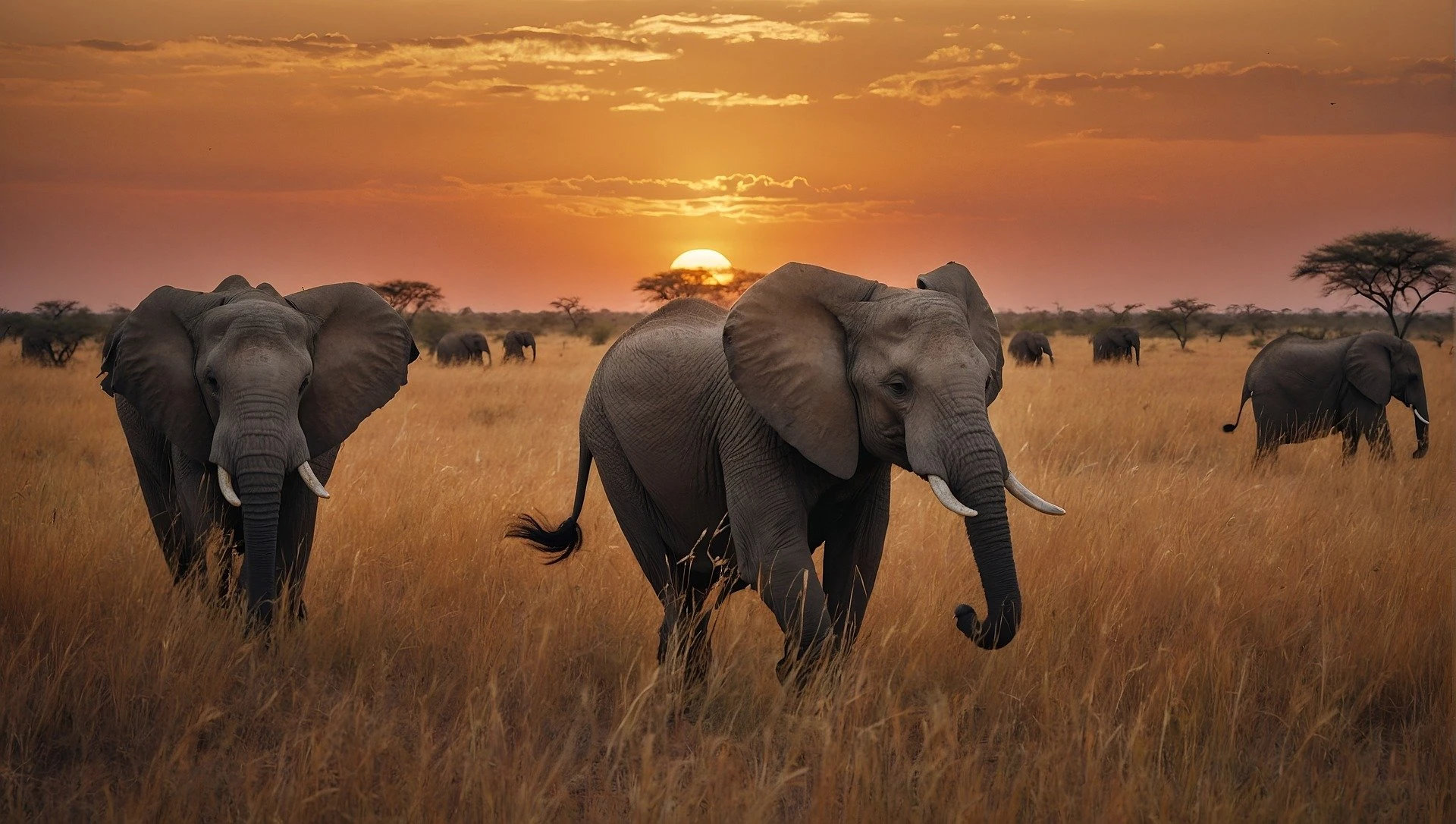
Tips for a Successful Migration Safari
Effective planning is crucial to make the most of your migration safari. Visiting during shoulder seasons with fewer tourists offers a more intimate experience. Staying within your vehicle and following your guide’s instructions ensures safety while viewing wildlife.
To capture stunning photos, bring a zoom lens and respect wildlife while photographing. Essential items like binoculars, sunscreen, and a reusable water bottle keep you comfortable and prepared throughout your adventure.
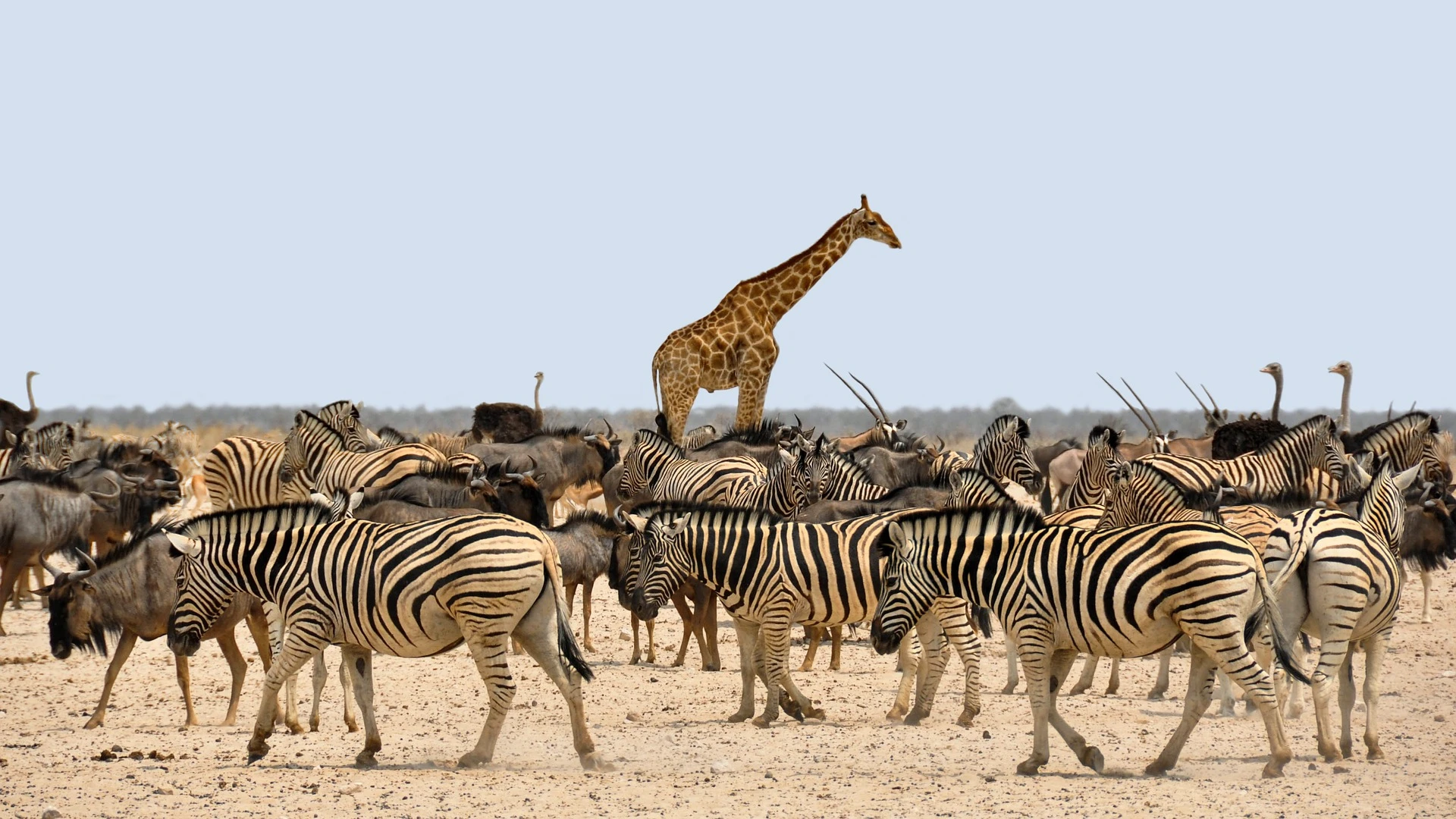
Summary & FAQs of Mara-Serengeti Migration
In summary, planning a Wildebeest Migration tour requires careful timing, thoughtful planning, and an appreciation for the dynamic Serengeti-Mara ecosystem. From the birthing season to the dramatic crossings of the river, each phase of the migration offers unique and unforgettable experiences. By considering the best times to visit, top locations for viewing, and different types of safaris available, you can tailor your adventure to create memories that will last a lifetime. So pack your bags, embrace the adventure, and witness one of nature’s greatest spectacles.
1. When is the best time to witness the Great Wildebeest Migration?
The ideal time to witness the Great Wildebeest Migration is from July to October, particularly during the Mara River crossings in late July to August. This period offers the most dramatic and exciting experiences.
2. What are the key locations for viewing the migration?
The key locations for viewing the migration are the Maasai Mara, Kichakani Serengeti Camp, Singita Faru Faru Lodge, and Sayari Camp. These spots offer some of the best experiences for observing this incredible wildlife event.
3. How should I plan my Wildebeest Migration Safari?
To plan your Wildebeest Migration Safari effectively, book accommodations well in advance and pack essential items. Opting for guided safaris can also enhance your experience significantly.
4. What types of safaris are available?
A variety of safari types are available, including mobile camps, luxury lodges, walking safaris, and air safaris. Choose the one that best suits your adventure style and comfort level.
5. What other wildlife can be seen during the migration?
During the migration, you can also observe lions, leopards, elephants, and a variety of bird species. Each of these animals contributes to the rich tapestry of wildlife in the area.
